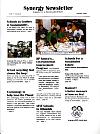

synergy vol 1 issue 2
Window
on the Future...
What I Learned
in the Rainforest
by Tachi
Kiuchi
Part 2
![]()
I learned that saving the rainforests - in fact, saving the environment-is more than an environmental necessity. It is a business opportunity. In our case, it is an opportunity to further advance Vision 21, to pursue business opportunities that use creativity and technology to substitute for trees, for resources of any kind.
After I visited the rainforest, we spoke with Amory Lovins, the famous expert on resource efficiency. We asked him to lead a global study team, to discover what opportunities business had to save forests. He agreed, and established the Systems Group on Forests. In a few weeks, his Systems Group will release a series of reports that show how businesses like yours and mine can help to reverse the systemic causes of forest destruction.
If you want to take advantage of these opportunities, and invest in business pursuits that could help save the rainforests, please give me your card.
But I learned something else in the rainforest, something more profound. I learned how we might operate our company not just to save the rainforest, but to be more like the rainforest.
Let me explain. As I said earlier, today's fast-changing business environment requires that we be alert, and responsive. Agile, and creative.
To do so, we must structure our company so we are a learning organization. Not top-down, but bottom-up. Not centralized, but decentralized. Not limited by rules, but motivated by objectives. Not structured like a machine-which cannot learn-but like a living system, which can.
When I visited the rainforest, I realized that it was a model of the perfect learning organization. A place that excels by learning to adapt to what it doesn't have.
A rainforest has almost no resources. The soil is thin. There are few nutrients. It consumes almost nothing. Wastes are food. Design is capital. My model for Mitsubishi Electric. An organization that is like a rainforest.
Here is what a banker would say if asked to make a loan to a rainforest: "No way!"
After all, it has no productive assets.
Yet rainforests are incredibly productive. They are home to millions of types of plants and animals, and more than two-thirds of all biodiversity in the world. Those plants and animals are so perfectly mixed that the system is more efficient, and more creative, than any business in the world.
Imagine how creative, how productive, how ecologically benign we could be if we could run our companies like the rainforest?
How can we begin?
By operating less like a machine, and more like a living system. An Industrial Ecosystem.
That is why, at Mitsubishi Electric, we have begun to adopt an environmental management system founded on principles of Industrial Ecology. For us, this means two things:
First, we must have our eyes wide open, and see the environmental costs and benefits of our business.
Second, based on what we see, must take action.
- See Costs -- reduce them.
- See benefits -- increase them.
- See needs -- fill them.
Not just inside the company, but throughout the community, locally and globally. We must take responsibility for the impacts of our products, from cradle to cradle.
So, instead of keeping environmental affairs separate from the core operations of our company, we are integrating it.
For example:
- We recently combined our Environmental Management and Quality Management programs. From now on, it is not just quality of product. It is quality of the Earth.
- We also combined our Product TakeBack effort with our Design for Environment program. The United Nations awarded us the Habitat II award for this initiative. I have copies of an article on this program, for those of you who are interested.
- We combined ISO 14000 -- the new international environmental management standard-with our Natural Step program The Natural Step is a program developed in Sweden to help companies avoid products and processes that violate principles of sustainability in nature. We recently trained all our North American managers in The Natural Step, the Swedish-based program that helps companies operate within nature's limits. I am told I was the first CEO of a major company to take The Natural Step training. Now we are working with Paul Hawken and Karl Henrik Robert (row-BEAR) to help bring the training to Japan.
Finally, we are looking for ways to combine our efforts with those of others. Maybe some of you.
To do that, we are sponsoring a series of roundtable discussions about Industrial Ecology and advanced resource productivity. We call the participants in these discussions The Future 500. Time will tell whether the name is correct.
I invite you now to join in this process.
If The Future 500 and Industrial Ecology are subjects that interest you, I hope you will join me at two events - write the dates in your calendars now:
- September 18 to 21, 1997 -- the Ecotech Conference, in Monterey, California.
- April 24 to 26, 1998 -- Industrial Ecology III, in San Francisco. California.
Through these discussions, we intend to find business opportunities that will help preserve the Earth. We intend to redirect our investments in ways that will be as productive as a rainforest.
Which brings me to my third lesson from the rainforest.
How can rainforests be so productive when they seem to have no capital assets?
They are productive because their capital is hidden in their design.
![]()
SFSF
Schools For a Sustainable Future

1 Curdies St.
E. Bentleigh Vic. 3165
Email:
Joe Natoli
Ph: (03) 9579-7224 Fax:
(03) 9579-6153 Mobile: 0411-568-523
Website
designed & maintained by
